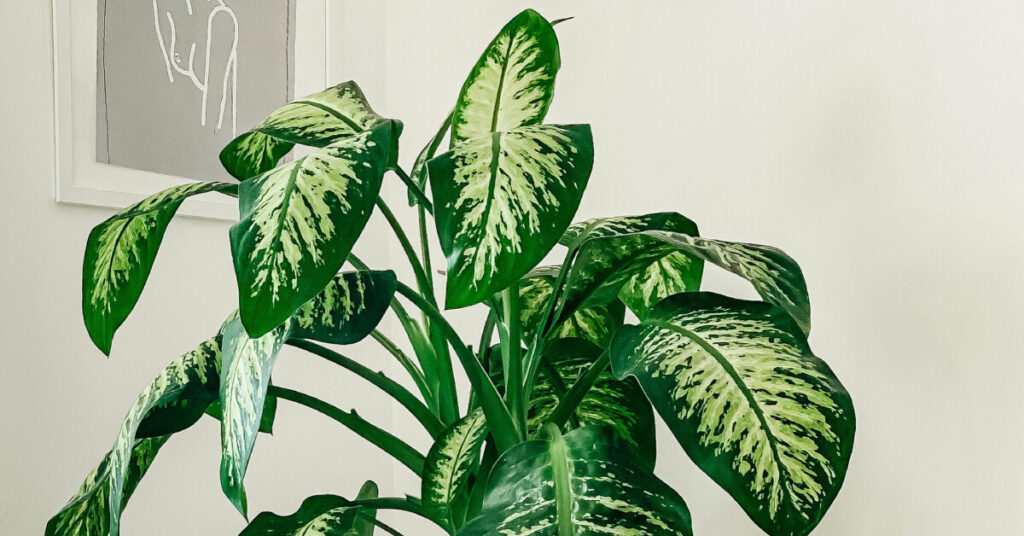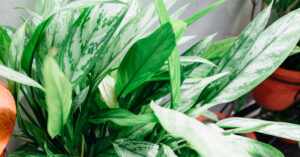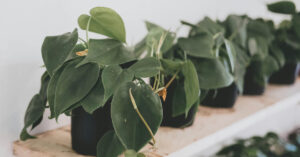Dieffenbachia
The Dumb Cane is a classic and popular houseplant renowned for its large, often variegated leaves that display striking patterns of green, cream, white, and yellow. With its upright growth habit and lush, dramatic foliage, the Dieffenbachia makes a bold tropical statement in any indoor setting, from living rooms to offices. Its common name, “Dumb Cane,” refers to a temporary speechlessness that can occur if the plant’s sap is ingested, highlighting the importance of handling it with care. Despite this, its relatively straightforward care and impressive visual appeal make it a cherished addition for many plant enthusiasts seeking to add a touch of exotic flair.
Cultivating Your Dieffenbachia: Light, Water, and Warmth Essentials
To ensure your Dumb Cane thrives and maintains its vibrant leaf patterns, providing the right environmental conditions is crucial.
Illumination Needs: Dieffenbachia plants prefer medium indirect light to low light. While they can tolerate lower light levels, their variegation may become less pronounced, and growth can slow. Bright indirect light is ideal for showcasing their stunning leaf patterns. Direct sunlight, especially harsh afternoon rays, should be avoided as it can scorch their large, sensitive leaves, leading to unsightly brown spots. Rotate the plant periodically to ensure even growth and prevent it from leaning towards the light source.
Watering Wisdom: Adopt a moderate watering approach for your Dumb Cane. Allow the top 2-3 inches of the soil to dry out completely between waterings. When you do water, do so thoroughly until water begins to drain from the bottom of the pot. It is critical to ensure the plant is never left sitting in stagnant water, as soggy conditions are a primary cause of root rot, a common issue for this plant. Reduce watering frequency during the cooler, darker months when the plant’s growth naturally slows down.
Atmospheric Comfort: Dieffenbachia plants appreciate medium to high humidity, mirroring their tropical origins. Average household humidity levels are often sufficient, but if your indoor air is particularly dry, especially in winter with heating, boosting humidity will benefit your plant. Consider using a humidifier nearby, grouping it with other plants, or placing its pot on a pebble tray filled with water (ensuring the pot isn’t sitting directly in the water). Misting can offer a temporary boost but isn’t a long-term solution for consistent humidity.
Temperature Preferences: These tropical beauties thrive in consistent warmth, ideally between 65-75°F (18-24°C). They are sensitive to cold and should be protected from drafts, sudden temperature fluctuations, or temperatures falling below 60°F (15°C). Cold stress can lead to leaf yellowing, browning, and eventual leaf drop.
Nurturing Your Dieffenbachia: Soil, Feeding, and General Care
Beyond the environmental basics, providing proper nutrients and regular care will ensure your Dumb Cane remains a lush and healthy focal point in your home.
The Right Foundation: Soil Type: A well-draining, peat-based potting mix, rich in organic matter, is ideal for the Dumb Cane. A good quality indoor potting mix can be amended with perlite or orchid bark to improve aeration and drainage, preventing the soil from becoming waterlogged. This balance allows for adequate moisture retention without suffocating the roots.
Feeding for Flourish: During the active growing season in spring and summer, fertilize your Dieffenbachia monthly with a balanced liquid fertilizer. It is important to dilute the fertilizer to half strength to prevent nutrient burn, which can damage the roots. In the fall and winter, when the plant’s growth naturally slows down, reduce or cease fertilizing entirely as the plant is in a period of dormancy.
Tending to Health: Dieffenbachia leaves can collect dust, so wipe them gently with a damp cloth periodically to keep them clean and allow for efficient photosynthesis. Prune any yellowing, browning, or damaged leaves at their base using clean, sharp scissors or pruners. If the plant becomes too tall or leggy, you can “cane” it by cutting the stem back to a desired height. This encourages new growth from the base or lower nodes. Be mindful that the sap can be irritating, so wear gloves when pruning.
Popular Dumb Cane Varieties
Dieffenbachia boasts a fantastic array of cultivars, each offering unique patterns and colors, allowing you to choose one that perfectly complements your decor:
- Dieffenbachia ‘Camilla’: One of the most popular varieties, ‘Camilla’ features creamy white to pale yellow centers on its leaves, framed by dark green margins, creating a bright and elegant contrast.
- Dieffenbachia ‘Tropic Marianne’: This variety displays large, broad leaves with a vibrant chartreuse-green center that fades into a darker green toward the edges, offering a bold splash of color.
- Dieffenbachia ‘Compacta’: As its name suggests, ‘Compacta’ is a smaller, bushier variety, ideal for tighter spaces, with light green leaves mottled with darker green and white specks.
- Dieffenbachia ‘Reflector’: A striking and unique variety, ‘Reflector’ has very dark green leaves speckled with lighter green and yellow-green, creating an almost camouflage-like pattern.
- Dieffenbachia ‘Amoena’: This classic type features dark green leaves with distinct creamy-white blotches along the main veins, offering a timeless, elegant look.
Propagating Your Dieffenbachia: Expanding Your Collection
Propagating Dieffenbachia is a straightforward process, allowing you to create new plants from existing ones, especially useful if your plant has become leggy:
- Stem Cuttings: The most common method involves taking stem cuttings. Cut a section of stem about 4-6 inches long that has at least one or two nodes (where leaves or roots grow from). Ensure each cutting has at least one healthy leaf if possible.
- Allow to Callus: Allow the cut end of the stem to dry and callus over for a day or two to prevent rot when planted.
- Planting: Plant the callused cutting directly into a small pot filled with moist, well-draining potting mix. You can also root cuttings in water, ensuring at least one node is submerged.
- Providing Warmth and Humidity: Place the pot or glass in a warm location with bright indirect light. High humidity can aid rooting; consider covering the pot with a plastic bag or placing it in a propagation dome.
- Patience: Rooting can take several weeks. Once new leaves begin to emerge, the cutting has successfully rooted.
Toxicity and Handling Precautions
It is crucial to understand that all parts of the Dieffenbachia plant are highly toxic if ingested, due to the presence of calcium oxalate crystals. Chewing on the plant can cause intense pain, burning, swelling of the mouth and throat, and temporary speechlessness, which is how it earned its common name “Dumb Cane.” In severe cases, swelling can be significant enough to impede breathing.
- Always wear gloves when handling, pruning, or propagating Dieffenbachia to avoid skin irritation from the sap.
- Keep this plant strictly out of reach of curious pets and small children. If ingestion is suspected, seek immediate medical or veterinary attention.
The Enduring Appeal of the Dumb Cane
The Dumb Cane remains a popular and impactful houseplant for good reason. Its dramatic foliage and relatively easy care make it an excellent choice for adding a lush, tropical aesthetic to your indoor spaces. With proper light, watering, and an understanding of its unique needs and toxicity, your Dieffenbachia will continue to be a striking and rewarding presence in your home for many years to come.




